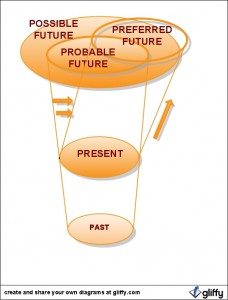Where Do You Want To Go with Your Small Group Ministry?
 Have you ever actually thought through where you want to go with your small group ministry? Have you ever looked further ahead than this year and dreamed about what things will look like in 10 years? I mean really took some pains to describe the preferred future of your small group ministry?
Have you ever actually thought through where you want to go with your small group ministry? Have you ever looked further ahead than this year and dreamed about what things will look like in 10 years? I mean really took some pains to describe the preferred future of your small group ministry?
Tom Peters described vision as a “picture of a preferred future.” I love that definition. Vision is seeing word. I’ve been using this diagram* to describe a number of important concepts in small group ministry. My article, This Road Doesn’t Go There illustrates the fact that only a new trajectory arrives at the preferred future. You Are Here begins to tease out the idea that where you are today is a result of decisions you’ve made in the past.
Today I want to focus on the preferred future for your small group ministry. This really is a huge concept, much more than we can talk through adequately in a single article, but we can begin to look at it. Here are three aspects you need to see:
- The preferred future has elements of your probable future. Remember, we’ve already pointed out the fact that once you really know the truth about your present, you will be very close to knowing how things will turn out in 10 years if nothing changes. But you probably wouldn’t want everything to change. Some of what you’re doing is already good or even great.
- The preferred future also has elements of the possible future. One of the most important steps in defining your preferred future is to dream broadly about what could happen. Use flip charts and markers. Pull together the dreamers in your organization and think about what you’d do in small group ministry if you knew you couldn’t fail. What are all the things that are possible?
- I also want you to notice that some of the preferred future in the diagram is actually outside the lines of what’s possible. That is intentional. You need to think that way. You need to think beyond what you could reasonable expect to do in your own power. That’s where God comes in. You also need to realize that some of what can happen in the future is outside the boundaries of today but won’t be outside the boundaries tomorrow.
This third aspect of the preferred future is very significant. You can’t know what it will be exactly…but you need to be able to stretch your imagination beyond what you actually think is possible. Thinking beyond what is possible today and moving as close to the edges of what’s possible is what puts you in striking distance of what scientist Stuart Kauffman calls the adjacent possible (described in Steven Johnson’s Where Good Ideas Come From).
“The adjacent possible is a kind of shadow future, hovering on the edges of the present state of things, a map of all the ways the present can reinvent itself (p. 31, Where Good Ideas Come From).”
Here’s a quick illustration of how the adjacent possible works:
- The development of DVD-driven curriculum made it possible for people with the gift of hospitality to lead a small group. You don’t need a teacher if you have Rick Warren on the DVD.
- The Small Group Connection made it possible to connect people without a prequalified leader and for leaders to be identified during an event.
- The HOST concept made it possible to connect people who didn’t come to an event. Asking volunteers to host a group and invite their own members made it possible to connect the friends and neighbors of everyone in the congregation.
- The Church-Wide Campaign made it possible to jump-start a large number of groups at one time, even to have more people in groups than you have at your weekend services.
That’s where we stand right now. It is now possible to ask for volunteer hosts who have no teaching gifts or abilities, to host a vibrant group where disciples are being made. Who would have thought that 10 or 20 years ago?
Are we now on the final frontier of what is actually possible? I say we’re not.
What if a topic was identified that people outside the congregation could choose to form a group around? What if a compelling topic was identified and then developed in a way that people outside the congregation (or on the very edges of the crowd) would pick it up and form their own group?
That’s a taste of the adjacent possible. What have you got? I’d love to hear your idea!
* I first saw this diagram in Turning the Future into Revenue, a business book by Glen Hiemstra.


Thanks for the article. I am needing direction and your website is a great help!
Glad you’re finding help here Frances!
mark